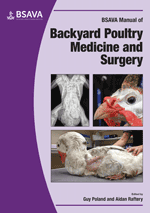
Full text loading...

A thorough individual and flock history, and clinical examination is essential to be able to make diagnostic and therapeutic plans. This chapter explains history taking and clinical examination in depth, as well as emergency triage and treatment. The chapter is extensively illustrated with photographs of both physiological and pathological presentations.
Clinical examination and emergency treatment, Page 1 of 1
< Previous page | Next page > /docserver/preview/fulltext/10.22233/9781910443194/9781910443194.8-1.gif

Full text loading...





















